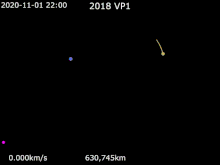2018 VP1
2018 VP1 (also written 2018 VP1) is an Apollo near-Earth asteroid roughly 2 meters (7 feet) in diameter. It has a 0.41% chance (1 in 240) of impacting Earth on 2 November 2020.[3] It was discovered on 3 November 2018 when the asteroid was about 0.003 AU (450,000 km; 280,000 mi) from Earth and had a solar elongation of 165 degrees. The asteroid has a short 12.9 day observation arc and has not been detected since November 2018. The JPL Horizons 2 November 2020 nominal Earth approach is estimated to be roughly 0.0028 AU (420,000 km; 260,000 mi).[2] The line of variation (LOV) allows the asteroid to impact Earth or pass as far away as 0.025 AU (3,700,000 km; 2,300,000 mi).[2] However, it is not listed as a Potentially hazardous asteroid due to its small size.
| Discovery[1] | |
|---|---|
| Discovered by | Zwicky Transient Facility |
| Discovery site | Palomar Mountain (I43) |
| Discovery date | 3 November 2018 |
| Designations | |
| 2018 VP1 | |
| Orbital characteristics[2] | |
| Epoch 27 April 2019 (JD 2458600.5) | |
| Uncertainty parameter 7 | |
| Observation arc | 12.9 days |
| Aphelion | 2.2701 AU (339,600,000 km) (Q) |
| Perihelion | 0.90524 AU (135,422,000 km) (q) |
| 1.5877 AU (237,520,000 km) (a) | |
| Eccentricity | 0.42983 (e) |
| 2.00 yr | |
| 103.60° (M) | |
| Inclination | 3.2419° (i) |
| 39.820° (Ω) | |
| 315.14° (ω) | |
| Earth MOID | 9700 km |
| Jupiter MOID | 3.1 AU (460,000,000 km) |
| Physical characteristics | |
| Dimensions | ~2 meters (7 feet)[3] |
| 30.9[2] | |
Description

Moon · Earth · 2018 VP1
2018 VP1 has a low 3.2° orbital inclination with respect to the ecliptic plane and an Earth-MOID of only 9700 km.[2] Since the asteroid last approached Earth in November 2018 and has a 2.00 year orbital period, the asteroid will approach Earth again in November 2020. Where Earth will be on a given date is known, but given the short observation arc and having not been observed since 2018 where precisely the asteroid will be on its orbit is not. The Sentry Risk Table shows an estimated 1 in 240 chance of the asteroid impacting Earth on 2 November 2020.[3] The nominal JPL Horizons 2 November 2020 Earth distance is 0.0028 AU (420,000 km; 260,000 mi) with a 3-sigma uncertainty of ± 4 million km.[2] NEODyS lists a nominal 31 October 2020 Earth approach of 0.007 AU (1,000,000 km; 650,000 mi).[4]
Impact line
The line of variation (LOV) passes across the Pacific Ocean.[5]
The asteroid will come to opposition (opposite the Sun in the sky) at the end of May 2020 at an estimated apparent magnitude of ~31,[6] and as a moving object will be much too faint for any telescope to detect. The November 2020 Earth approach will be hidden by the glare of the Sun.[6]
Since the asteroid is only about 2 meters (7 feet) in diameter it is too small to do more than create a bolide and common strewn field.
References
- "MPEC 2018-V42 : 2018 VP1". IAU Minor Planet Center. 4 November 2018. Retrieved 22 July 2019. (K18V01P)
- "JPL Small-Body Database Browser: (2018 VP1)" (last observation: 2018-11-16; arc: 13 days). Jet Propulsion Laboratory. Archived from the original on 21 July 2019. Retrieved 22 July 2019.
- "Earth Impact Risk Summary: 2018 VP1". NASA/JPL Near-Earth Object Program Office. Archived from the original on 5 March 2019. Retrieved 22 July 2019.
- "2018VP1 Close Approaches". NEODyS (Near Earth Objects – Dynamic Site). Archived from the original on 21 July 2019. Retrieved 22 July 2019.
- Path of risk (Peter Thomas, 26 July 2019)
- "2018VP1 Ephemerides for May–Nov 2020". NEODyS (Near Earth Objects – Dynamic Site). Archived from the original on 21 July 2019. Retrieved 22 July 2019.
External links
- List Of Apollo Minor Planets (by designation), Minor Planet Center
- 2018 VP1 at NeoDyS-2, Near Earth Objects—Dynamic Site
- Ephemeris · Obs prediction · Orbital info · MOID · Proper elements · Obs info · Close · Physical info · NEOCC
- 2018 VP1 at the JPL Small-Body Database
- IAWN: 2018 VP1 Geometry (2018 Approach)


